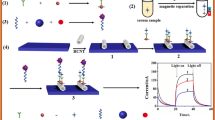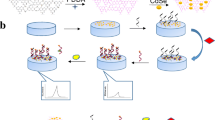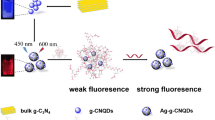Abstract
A “signal-off” sensor is described for sensitive photoelectrochemical (PEC) determination of the vascular endothelial growth factor (VEGF165). Graphitic carbon nitride (g-C3N4) is used as the signalling material, and porous carbon spheres as efficient quenchers of the photocurrent. The quenching efficiency of carbon spheres is the result of two effects, viz. (a) the competitive light absorption and (b) competitive electron donor activity which decreases the number of light-generated electrons and holes and also reduces the charge separation efficiency. This new mechanism differs from the previous quenching mechanisms which usually are based on the suppression of electron transport or steric hindrance. A glassy carbon electrode was modified with an aptamer against VEGF165. On binding of analyte (VEGF165), the reduction of current is measured (at a typical potential of 0 V) using H2O2 as the electrochemical probe. The sensor has a linear response in the 10−5 nM to 102 nM VEGF165 concentration range, and the detection limit is 3 fM.

Schematic presentation of the quenching mechanism of carbon spheres: the competitive light absorption and competitive electron donor reduce the number of light-generated electrons in the conduction band (CB) and holes in the valence band (VB) and also reduce the charge separation efficiency.






Similar content being viewed by others
References
Zhao WW, Xu JJ, Chen HY (2015) Photoelectrochemical bioanalysis: the state of the art. Chem Soc Rev 44:729–741
Chu YX, Deng AP, Wang WJ, Zhu JJ (2019) Concatenated catalytic hairpin assembly/Hyperbranched hybridization chain reaction based enzyme-free signal amplification for the sensitive Photoelectrochemical detection of human telomerase RNA. Anal Chem 91:3619–3627
Cheng WJ, Pan JH, Yang JY, Zheng ZY, Lu FS, Chen YW, Gao WH (2018) A photoelectrochemical aptasensor for thrombin based on the use of carbon quantum dot-sensitized TiO2 and visible-light photoelectrochemical activity. Microchim Acta 185:263
Zheng YN, Liang WB, Xiong CY, Yuan YL, Chai YQ, Yuan R (2016) Self-enhanced ultrasensitive Photoelectrochemical biosensor based on Nanocapsule packaging both donor-acceptor-type photoactive material and its sensitizer. Anal Chem 88:8698–8705
Qin CD, Bai X, Zhang Y, Gao K (2018) Photoelectrochemical CdSe/TiO2 nanotube array microsensor for high-resolution in-situ detection of dopamine. Microchim Acta 185:278
Zhou YL, Sui CJ, Yin HS, Wang Y, Wang MH, Ai SY (2018) Tungsten disulfide (WS2) nanosheet-based photoelectrochemical aptasensing of chloramphenicol. Microchim Acta 185:453
Da HM, Liu HY, Zheng YN, Yuan R, Chai YQ (2018) A highly sensitive VEGF165 photoelectrochemical biosensor fabricated by assembly of aptamer bridged DNA networks. Biosens Bioelectron 101:213–218
Yan K, Liu Y, Yang YH, Zhang JD (2015) A cathodic “signal-off” Photoelectrochemical Aptasensor for ultrasensitive and selective detection of Oxytetracycline. Anal Chem 87:12215–12220
Li MJ, Zheng YN, Liang WB, Yuan R, Chai YQ (2017) Using p-type PbS quantum dots to quench photocurrent of fullerene-au NP@MoS2 composite structure for ultrasensitive Photoelectrochemical detection of ATP. ACS Appl Mater Interfaces 9:42111–42120
Li MJ, Zheng YN, Liang WB, Yuan YL, Chai YQ, Yuan R (2016) An ultrasensitive “on-off-on” photoelectrochemical aptasensor based on signal amplification of a fullerene/CdTe quantum dots sensitized structure and efficient quenching by manganese porphyrin. Chem Commun 52:8138–8141
Fan GC, Zhu H, Du D, Zhang JR, Zhu JJ, Lin YH (2016) Enhanced Photoelectrochemical Immunosensing platform based on CdSeTe@CdS:Mn Core-Shell quantum dots-sensitized TiO2 amplified by CuS nanocrystals conjugated signal antibodies. Anal Chem 88:3392–3399
Hong GS, Diao S, Antaris AL, Dai HJ (2015) Carbon nanomaterials for biological imaging and Nanomedicinal therapy. Chem Rev 115:10816–10906
Kawamoto M, He P, Ito Y (2017) Green processing of carbon nanomaterials. Adv Mater 29:1602423
Cao CY, Andrews JB, Kumar A, Franklin AD (2016) Improving contact interfaces in fully printed carbon nanotube thin-film transistors. ACS Nano 10:5221–5229
Franklin AD, Luisier M, Han SJ, Tulevski G, Breslin CM, Gignac L, Lundstrom M, Haensch W (2012) Sub-10 nm carbon nanotube transistor. Nano Lett 12:758–762
Yang YJ, Ding L, Han J, Zhang ZY, Peng LM (2017) High-performance complementary transistors and medium-scale integrated circuits based on carbon nanotube thin films. ACS Nano 11:4124–4132
Wang Z, Yu Y, Gui R, Jin H, Xia Y (2016) Carbon nanomaterials-based electrochemical aptasensors. Biosens Bioelectron 79:136–149
Yang ZP, Ci LJ, Bur JA, Lin SY, Ajayan PM (2008) Experimental observation of an extremely dark material made by a low-density nanotube Array. Nano Lett 8:446–451
Kaul AB, Coles JB, Eastwood M, Green RO, Bandaru PR (2013) Ultra-high optical absorption efficiency from the ultraviolet to the infrared using multi-walled carbon nanotube ensembles. Small 9:1058–1065
Shamsipur M, Farzin L, Tabrizi MA, Molaabasi F (2015) Highly sensitive label free electrochemical detection of VGEF165 tumor marker based on “signal off” and “signal on” strategies using an anti-VEGF165 aptamer immobilized BSA-gold nanoclusters/ionic liquid/glassy carbon electrode. Biosens Bioelectron 74:369–375
Johari-Ahar M, Karami P, Ghanei M, Afkhami A, Bagheri H (2018) Development of a molecularly imprinted polymer tailored on disposable screen-printed electrodes for dual detection of EGFR and VEGF using nanoliposomal amplification strategy. Biosens Bioelectron 107:26–33
Moghadam FM, Rahaie M (2019) A signal-on nanobiosensor for VEGF165 detection based on supraparticle copper nanoclusters formed on bivalent aptamer. Biosens Bioelectron 132:186–195
Loureiro RM, D’amore PA (2005) Transcriptional regulation of vascular endothelial growth factor in cancer. Cytokine Growth Factor Rev 16:77–89
Chen HC, Qiu JT, Yang FL, Liu YC, Chen MC, Tsai RY, Yang HW, Lin CY, Lin CC, Wu TS, Tu YM, Xiao MC, Ho CH, Huang CC, Lai CS, Hua MY (2014) Magnetic-composite-modified polycrystalline silicon nanowire field-effect transistor for vascular endothelial growth factor detection and Cancer diagnosis. Anal Chem 86:9443–9450
Pan LH, Kuo SH, Lin TY, Lin CW, Fang PY, Yang HW (2017) An electrochemical biosensor to simultaneously detect VEGF and PSA for early prostate cancer diagnosis based on graphene oxide/ssDNA/PLLA nanoparticles. Biosens Bioelectron 89:598–605
Hsu MY, Chen SJ, Chen KH, Hung YC, Tsai HY, Cheng CM (2015) Monitoring VEGF levels with low-volume sampling in major vision-threatening diseases: age-related macular degeneration and diabetic retinopathy. Lab Chip 15:2357–2363
Xiong MY, Rong QM, Meng HM, Zhang XB (2017) Two-dimensional graphitic carbon nitride nanosheets for biosensing applications. Biosens Bioelectron 89:212–223
Zhao XH, Kong RM, Zhang XB, Meng HM, Liu WN, Tan WH, Shen GL, Yu RQ (2011) GrapheneDNAzyme based biosensor for amplified fluorescence “turn-on” detection of Pb2+ with a high selectivity. Anal Chem 83:5062–5066
Liao WC, Sohn YS, Riutin M, Cecconello A, Parak WJ, Nechushtai R, Willner I (2016) The application of stimuli-responsive VEGF- and ATP-aptamer-based microcapsules for the controlled release of an anticancer drug, and the selective targeted cytotoxicity toward Cancer cells. Adv Funct Mater 26:4262–4273
Yu HJ, Shi R, Zhao YX, Bian T, Zhao YF, Zhou C, Waterhouse GIN, Wu LZ, Tung CH, Zhang TR (2017) Alkali-assisted synthesis of nitrogen deficient graphitic carbon nitride with tunable band structures for efficient visible-light-driven hydrogen evolution. Adv Mater 29:1605148
Cao HX, Wang L, Pan CG, He YS, Liang GX (2018) Aptamer based electrochemiluminescent determination of bisphenol a by using carboxylated graphitic carbon nitride. Microchim Acta 185:463
Liu J, Qiao SZ, Liu H, Chen J, Orpe A, Zhao DY, Lu GQ (2011) Extension of the Stöber method to the preparation of monodisperse resorcinol-formaldehyde resin polymer and carbon spheres. Angew Chem Int Ed 50:5947–5951
Liu HY, Joo JB, Dahl M, Fu LS, Zeng ZZ, Yin YD (2015) Crystallinity control of TiO2 hollow shells through resin-protected calcination for enhanced photocatalytic activity. Energy Environ Sci 8:286–296
Lan JN, Li L, Liu YX, Yan L, Li CY, Chen JH, Chen XS (2016) Upconversion luminescence assay for the detection of the vascular endothelial growth factor, a biomarker for breast cancer. Microchim Acta 183:3201–3208
Freeman R, Girsh J, Jou AFJ, Ho JAA, Ja H, Dernedde J, Willner I (2012) Optical Aptasensors for the analysis of the vascular endothelial growth factor (VEGF). Anal Chem 84:6192–6198
Cao Y, Wang ZH, Cao JP, Mao XX, Chen GF, Zhao J (2017) A general protein aptasensing strategy based on untemplated nucleic acid elongation and the use of fluorescent copper nanoparticles: application to the detection of thrombin and the vascular endothelial growth factor. Microchim Acta 184:3697–3704
Li WY, Zhang QF, Zhou HP, Chen J, Li YX, Zhang CY, Yu C (2015) Chemiluminescence detection of a protein through the aptamer-controlled catalysis of a porphyrin probe. Anal Chem 87:8336–8341
Zhao S, Yang WW, Lai RY (2011) A folding-based electrochemical aptasensor for detection of vascular endothelial growth factor in human whole blood. Biosens Bioelectron 26:2442–2447
Zhang H, Li MX, Li CH, Guo ZH, Dong HL, Wu P, Cai CX (2015) G-quadruplex DNAzyme-based electrochemiluminescence biosensing strategy for VEGF165 detection: combination of aptamer-target recognition and T7 exonuclease-assisted cycling signal amplification. Biosens Bioelectron 74:98–103
Acknowledgements
This work was financially supported by the National Natural Science Foundation of China (Grant Nos. 21501081, 21675129, 51473136, and 21775124) and the Fundamental Research Funds for the Central Universities (XDJK2017C021, XDJK2018AA003).
Author information
Authors and Affiliations
Corresponding authors
Ethics declarations
The author(s) declare that they have no competing interests.
Additional information
Publisher’s note
Springer Nature remains neutral with regard to jurisdictional claims in published maps and institutional affiliations.
Electronic supplementary material
ESM 1
(DOC 4690 kb)
Rights and permissions
About this article
Cite this article
Liu, YL., Da, HM., Chai, YQ. et al. Photoelectrochemical aptamer-based sensing of the vascular endothelial growth factor by adjusting the light harvesting efficiency of g-C3N4 via porous carbon spheres. Microchim Acta 186, 275 (2019). https://doi.org/10.1007/s00604-019-3393-x
Received:
Accepted:
Published:
DOI: https://doi.org/10.1007/s00604-019-3393-x




